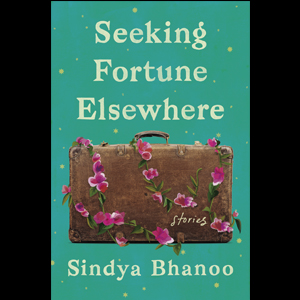Books: Finding Renewal and Emotional Truth

Another Indian-American fiction writer who grew up in Atlanta makes a splash! Sindya Bhanoo, a former New York Times science reporter who has also written for Khabar, is winning acclaim for her debut story collection. “Malliga Homes,” which won an O. Henry Prize, and seven other stories are included in Seeking Fortune Elsewhere.
It happens with acquaintances. We see someone rather unique at a gathering and are certain that we’ve met before. We speak to them, and if we are fortunate, they reciprocate the memory of a past meeting.
Can this re-connection happen with a book? Happily, I experienced such serendipity with the opening story of Sindya Bhanoo’s collection Seeking Fortune Elsewhere (Catapult).
The first sentence of “Malliga Homes” said to me Hello, we’ve met before: “Mr. Swaminathan died suddenly, as he was walking back to his flat from the Veg dining hall after dinner.” Being a vegetarian myself, that detail of the “Veg” dining hall had lodged itself in my reading memory. I sensed that I might have previously read this story. But how was that possible? I had in my hands a galley copy; the book had not yet been published. I recalled Bhanoo’s writing in The New York Times, but that was in the Science section, as far away from short fiction as a Big Mac is from my lips.
Suddenly, on page 16, there was a was a bolt of certain recognition: “I wish to hang up, but I think of my husband, and his palm on mine. I soften my tone.” I had first read this story in Granta magazine. It was as if I was at a social gathering, and that acquaintance introduces her husband; he says Namaste in that reassuring, unforgettable way, and you are sure that you’ve met before. I know this couple I exclaimed. How could I ever forget that spousal palm gently warning one to not trespass a boundary?
The other stories in the collection are the phantom acquaintance’s children; I’ve never met them before, but I read the same humanism in them that I see in the parents. But it’s the parents who I want to spend the evening with; it’s the parents I talk about with my own spouse on the drive home; it’s that sweet, impulsive woman and the gentle, supportive man whom I want to introduce to my own social circle. Sadly, years pass and the next time I call them, he has passed, and she is alone. Her children have moved away to another country. After reading her character, I am uncertain if she will want to be at a party with married couples.
I wondered if the other stories would have the same frisson of recognition of “Malliga Homes.” Just as I would readily spend time with the imagined children of my imaginary acquaintance, I spent quality time with the remaining seven stories in the collection.
Given Bhanoo’s eye for setting and detail, the stories are uniformly compelling. A couple of the stories (“Amma” and “No. 16 Model House Road”) have brilliantly developed characters, strong women who learn what it means to powerfully be their unsubordinated selves. All of the protagonists have an interiority that keeps you reading, keeps you interested in what the character is thinking. This is a testament to Bhanoo’s ability to get under the skin of characters as varied as the widow in “Malliga Homes,” the feckless divorcee in “Buddymoon,” the Kollywood film star who becomes Tamil Nadu’s Chief Minister in “Amma,” and the homeowner wife (not housewife, mind you) in “No. 16 Model House Road” who stays true to what she wants rather than what the world wants of her.

The grieving mother in “Nature Exchange” is one character who not only got under my skin, but also burrowed her way into my heart in a tender way. Bhanoo explains her interiority—literary jargon that I recently learned from a writing instructor—in one elegant sentence: “It is her own voice that speaks to her.” A couple of paragraphs earlier, the interiority is sensitively conveyed in writing about life and death after a school shooting takes away her family’s sole child:
[Veena] feels light-headed, a little dizzy. She looks up and knows how it seems to them. Their faces, all their faces, are twisted with pity. The older woman understands her pain, the younger one is alarmed. Mitchell is alive and present, but too long in her company and he would decay.
[Right] Sindya Bhanoo
(Photo: Brian Birzer)
While I miss reading Bhanoo in The New York Times, I took great pleasure in reading her debut short story collection about characters living with loss. Just as I used to look forward to her next piece in The Times, I look forward to her next work of fiction, perhaps a novel about Professor Chand from “A Life in America.” It may be a prequel or sequel; but like this collection, I imagine that whatever Sindya Bhanoo writes next, it is sure to be full of empathy and emotional truth.
RCO, who is presently in Stanford University’s two-year novel-writing intensive, looks forward to publishing his debut novel. A consultant to organizations and individuals requiring change leadership, he can be reached at raj.oza@sbcglobal.net.
Enjoyed reading Khabar magazine? Subscribe to Khabar and get a full digital copy of this Indian-American community magazine.
blog comments powered by Disqus












